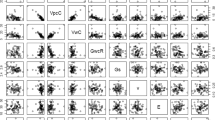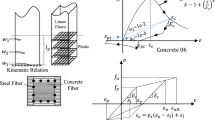Abstract
This paper proposes an improved theoretical prediction equation for Concrete-filled steel tubes (CFT) subjected to compressive forces. This ultimate load capacity is inferred from a database of 344 experimental results reported in the literature by using Gene expression programming (GEP). Moreover, a series of structural comparisons between design provisions, other mechanically-derived expressions and the proposed prediction are addressed. The levels of accuracy, practical use and phenomenological understanding of the phenomenon are pinpointed. The results obtained are in good agreement with both the experimental and theoretical predictions. Advantages and disadvantages of such type of predictions are pinpointed.
Similar content being viewed by others
References
M. Johansson, The efficiency of passive confinement in CFT columns, Steel Compos. Struct., 2 (2002) 379–396.
K. A. S. Susantha, H. Ge and T. Usami, A capacity prediction procedure for concrete-filled steel columns, J. Earthq. Eng., 5 (4) (2001) 483–520.
G. D. Hatzigeorgiou, Numerical model for the behavior and capacity of circular CFT columns, Part I: Theory, Eng. Struct., 30 (6) (2008) 1573–1578.
R. Chacón, E. Mirambell and E. Real, Resistance of concrete-filled tubular structures (CFT) on integral bridges, Inf. Constr., 64 (527) (2012) 355–370.
Bradford Centre for Sustainable Environments (2014).
J. Hajjar, B. Gourley, C. Tort, M. Denavit and P. Schiller, Steel-concrete composite structural systems, Department of Civil and Environmental Engineering, Northeastern University (2013).
F. Zhou and W. Xu, Cyclic loading tests on concrete-filled double-skin (SHS outer and CHS inner) stainless steel tubular beam-columns, Eng. Struct., 127 (2016) 304–318.
H. J. Kim, J. W. Hu and W. S. Hwang, Cyclic testing for structural detail improvement of CFT column-foundation connections, Sustain., 7 (5) (2015) 5260–5281.
J. W. Hu and W. S. Hwang, Design and behavior of recentering beam-to-CFT column connections with super-elastic shape memory alloy fasteners, Int. J. Steel Struct., 13 (1) (2013) 55–69.
J. W. Hu and R. T. Leon, Analyses and evaluations for composite-moment frames with SMA PR-CFT connections, Nonlin. Dyn., 65 (4) (2011) 433–455.
J. W. Hu, E. Choi and R. T. Leon, Design, analysis and application of innovative composite PR connections between steel beams and CFT columns, Smart Mater. Struct., 20 (2) (2011).
J. W. Hu, J. Park and R. T. Leon, Advanced analysis and performance based evaluation of concrte filled tube (CFT) columns, Adv. Steel Constr., 6 (4) (2010) 1019–1033.
C. Ferreira, Gene expression programming: A new adaptive algorithm for solving problems, Complex Syst., 13 (2) (2001) 87–129.
C. Ferreira, Gene expression programming: Mathematical Modeling by an Artificial Intelligence, 2 Ed., Springer, Germany (2006).
C. Ferreira, Designing neural networks using gene expression programming, Advances in Soft Computing (2006) 517–535.
E. A. Colbourn, S. J. Roskilly, R. C. Rowe and P. York, Modelling formulations using gene expression programming-A comparative analysis with artificial neural networks, Eur. J. Pharm. Sci., 44 (3) (2011) 366–374.
A. H. Gandomi, A. H. Alavi, S. Kazemi and M. Gandomi, Formulation of shear strength of slender RC beams using gene expression programming, part I: Without shear reinforcement, Autom. Constr., 42 (2014) 112–121.
E. M. Güneyisi, M. D'Aniello, R. Landolfo and K. Mermerdas, A novel formulation of the flexural overstrength factor for steel beams, J. Constr. Steel Res., 90 (2013) 60–71.
A. H. Gandomi, S. K. Babanajad, A. H. Alavi and Y. Farnam, Novel approach to strength modeling of concrete under triaxial compression, J. Mater. Civil Eng., 24 (9) (2012) 1132–1143.
A. Gholampour, A. H. Gandomi and T. Ozbakkaloglu, New formulations for mechanical properties of recycled aggregate concrete using gene expression programming, Constr. Build. Mater., 130 (2017) 122–145.
S. Jafari and S. S. Mahini, Lightweight concrete design using gene expression programing, Constr. Build. Mater., 139 (2017) 93–100.
G. Abdollahzadeh, E. Jahani and Z. Kashir, Predicting of compressive strength of recycled aggregate concrete by genetic programming, Comput. Concrete., 18 (2) (2016) 155–164.
A. H. Gandomi, A. H. Alavi, M. Gandomi and S. Kazemi, Formulation of shear strength of slender RC beams using gene expression programming, part II: With shear reinforcement, Measurement: J. Int. Measurement Confederation, 95 (2017) 367–376.
M. E. M. Güneyisi, E. Güneyisi, M. E. Yilmaz and K. Mermerdas, Modeling and analysis of the shear capacity of adhesive anchors post-installed into uncracked concrete, Composites Part B: Eng., 60 (2014) 716–724.
E. M. Güneyisi, M. Gesoğlu, E. Güneyisi and K. Mermerdas, Assessment of shear capacity of adhesive anchors for structures using neural network based model, Mater. Struct., 49 (3) (2016) 1065–1077.
E. M. Güneyisi, A. Gültekin and K. Mermerdas, Ultimate capacity prediction of axially loaded CFST short columns, Int. J. Steel Struct., 16 (1) (2016) 99–114.
I. Mansouri, J. W. Hu and O. Kisi, Novel predictive model of the debonding strength for masonry members retrofitted with FRP, Appl. Sci., 6 (11) (2016).
L. Chen, C. H. Kou and S. W. Ma, Prediction of slump flow of high-performance concrete via parallel hyper-cubic gene-expression programming, Eng. Appl. Artif. Intel., 34 (2014) 66–74.
M. Saridemir, Empirical modeling of flexural and splitting tensile strengths of concrete containing fly ash by GEP, Computers and Concrete, 17 (4) (2016) 489–498.
M. D'Aniello, E. M. Güneyisi, R. Landolfo and K. Mermerdas, Predictive models of the flexural overstrength factor for steel thin-walled circular hollow section beams, Thin-Wall. Struct., 94 (2015) 67–78.
A. Johari, A. A. Javadi and H. Najafi, A genetic-based model to predict maximum lateral displacement of retaining wall in granular soil, Sci. Iranica, 23 (1) (2016) 54–65.
E. Kanca, F. Çavdar and M. M. Ersen, Prediction of mechanical properties of cold rolled steel using genetic expression programming, Acta Phys. Pol. A, 130 (1) (2016) 365–369.
I. F. Kara, Prediction of shear strength of FRP-reinforced concrete beams without stirrups based on genetic programming, Adv. Eng. Softw., 42 (6) (2011) 295–304.
Richart F., Brandtzaeg A. and Brown R., A study of the failure of concrete under combined compressive stresses, Bulletin. University of Illinois, 26 (12) (1928).
N. J. Gardner and E. R. Jacobson, Structural behavior of concrete filled steel tubes, ACI J., 64 (7) (1967) 404–413.
W. L. A. de Oliveira, S. De Nardin, A. L. H. de Cresce El Debs and M. K. El Debs, Influence of concrete strength and length/diameter on the axial capacity of CFT columns, J. Construct. Steel Res., 65 (12) (2009) 2103–2110.
A. T. Beck, W. L. A. de Oliveira, S. De Nardim and A. L. H. C. ElDebs, Reliability-based evaluation of design code provisions for circular concrete-filled steel columns, Eng. Struct., 31 (10) (2009) 2299–2308.
A. Kuranovas, D. Goode, A. K. Kvedaras and S. Zhong, Load-bearing capacity of concrete-filled steel columns, J. Civil Eng. Manage., 15 (1) (2009) 21–33.
R. Chacón, E. Mirambell and E. Real, Strength and ductility of concrete-filled tubular piers of integral bridges, Eng. Struct., 46 (2013) 234–246.
B. Evirgen, A. Tuncan and K. Taskin, Structural behavior of concrete filled steel tubular sections (CFT/CFSt) under axial compression, Thin-Wall. Struct., 80 (2014) 46–56.
Z. H. Lu and Y. G. Zhao, Suggested empirical models for the axial capacity of circular CFT stub columns, J. Constr. Steel Res., 66 (6) (2010) 850–862.
A. Mollahasani, A. H. Alavi and A. H. Gandomi, Empirical modeling of plate load test moduli of soil via gene expression programming, Computers and Geotechnics, 38 (2) (2011) 281–286.
J. R. Koza, Genetic programming: On the programming of computers by means of natural selection, Cambridge: MIT Press (1992).
Y. Pan, J. Jiang, R. Wang, H. Cao and Y. Cui, A novel QSPR model for prediction of lower flammability limits of organic compounds based on support vector machine, J. Hazard. Mater., 168 (2-3) (2009) 962–969.
M. Ðurasević, D. Jakobović and K. Knežević, Adaptive scheduling on unrelated machines with genetic programming, Appl. Soft Comput., 48 (2016) 419–430.
Design of composite steel and concrete structures. Part 1: General rules and rules for buildings, Design of Composite Steel and Concrete Structures (1994).
A. Aytek, O. Kisi and A. Guven, A genetic programming technique for lake level modeling, Hydrol. Res., 45 (4-5) (2014) 529–539.
Author information
Authors and Affiliations
Corresponding author
Additional information
Recommended by Associate Editor Jaewook Lee
Iman Mansouri received his Ph.D. degree from Department of Civil Engineering in Shahid Bahonar University of Kerman. Currently, he has been an Assistant Professor at Department of Civil Engineering, Birjand University of Technology. His research interests are in the area of nonlinear structural analysis, earthquake engineering, seismic retrofitting, performance-based design and soft computing methods.
Rolando Chacón received his M.S. and Ph.D. degrees from Department of Civil and Environmental Engineering in Technical University of Catalonia. Currently, he is an Associate Professor at the Chair of Steel Structures of the School of Civil Engineering. His research interests are in the area of instability and ductility of steel and composite structures, numerical and experimental methods in structural analysis and innovative teaching in structural engineering. He is an active member of technical committees of ECCS.
Jong Wan Hu received his M.S. degrees from (1) G.W.W. School of Mechanical Engineering and (2) School of Civil and Environmental Engineering, respectively, in Georgia Institute of Technology, USA. He then received his Ph.D. degree from School of Civil and Environmental Engineering, Georgia Institute of Technology, USA. He has been Post-Doctorate Research Fellow at Structural, Mechanics, and Material Research Group in Georgia Institute of Technology. He also worked as an Associate Research Fellow at the Korea Institute of S&T Evaluation and Planning (KISTEP) and an Assistant Administrator at the National S&T Council (NSTC) for two years. He is currently an Associate Professor in the Incheon National University. He has been active in the member of ASME and ASCE. His research interests are in the area of computational solid mechanics, composite materials, and plasticity modeling.
Rights and permissions
About this article
Cite this article
Mansouri, I., Chacón, R. & Hu, J.W. Improved predictive model to the cross-sectional resistance of CFT. J Mech Sci Technol 31, 3887–3895 (2017). https://doi.org/10.1007/s12206-017-0733-9
Received:
Revised:
Accepted:
Published:
Issue Date:
DOI: https://doi.org/10.1007/s12206-017-0733-9




